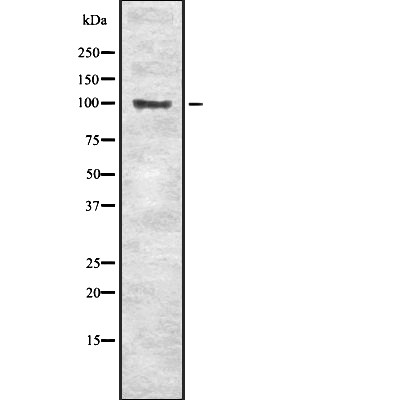Band 3/AE 1 Antibody - #DF7843
| Product: | Band 3/AE 1 Antibody |
| Catalog: | DF7843 |
| Description: | Rabbit polyclonal antibody to Band 3/AE 1 |
| Application: | WB IF/ICC |
| Reactivity: | Human, Mouse |
| Prediction: | Horse, Rabbit, Dog |
| Mol.Wt.: | 102 kDa; 102kD(Calculated). |
| Uniprot: | P02730 |
| RRID: | AB_2841281 |
Related Downloads
Protocols
Product Info
*The optimal dilutions should be determined by the end user. For optimal experimental results, antibody reuse is not recommended.
*Tips:
WB: For western blot detection of denatured protein samples. IHC: For immunohistochemical detection of paraffin sections (IHC-p) or frozen sections (IHC-f) of tissue samples. IF/ICC: For immunofluorescence detection of cell samples. ELISA(peptide): For ELISA detection of antigenic peptide.
Cite Format: Affinity Biosciences Cat# DF7843, RRID:AB_2841281.
Fold/Unfold
AE 1; AE1; Anion exchange protein 1; Anion exchanger 1; B3AT_HUMAN; Band 3 anion transport protein; BND3; CD233; DI; Diego blood group; EMPB3; EPB3; Erythrocyte membrane protein band 3; Erythroid anion exchange protein; FR; Froese blood group; RTA1A; SLC4A1; Solute carrier family 4 anion exchanger member 1; Solute carrier family 4 member 1; SW; Swann blood group; Waldner blood group; WD; WD1; WR; Wright blood group;
Immunogens
A synthesized peptide derived from human Band 3/AE 1, corresponding to a region within the internal amino acids.
Detected in erythrocytes (at protein level) (PubMed:7506871, PubMed:26542571). Isoform 2 is expressed in kidney (at protein level) (PubMed:7506871).
- P02730 B3AT_HUMAN:
- Protein BLAST With
- NCBI/
- ExPASy/
- Uniprot
MEELQDDYEDMMEENLEQEEYEDPDIPESQMEEPAAHDTEATATDYHTTSHPGTHKVYVELQELVMDEKNQELRWMEAARWVQLEENLGENGAWGRPHLSHLTFWSLLELRRVFTKGTVLLDLQETSLAGVANQLLDRFIFEDQIRPQDREELLRALLLKHSHAGELEALGGVKPAVLTRSGDPSQPLLPQHSSLETQLFCEQGDGGTEGHSPSGILEKIPPDSEATLVLVGRADFLEQPVLGFVRLQEAAELEAVELPVPIRFLFVLLGPEAPHIDYTQLGRAAATLMSERVFRIDAYMAQSRGELLHSLEGFLDCSLVLPPTDAPSEQALLSLVPVQRELLRRRYQSSPAKPDSSFYKGLDLNGGPDDPLQQTGQLFGGLVRDIRRRYPYYLSDITDAFSPQVLAAVIFIYFAALSPAITFGGLLGEKTRNQMGVSELLISTAVQGILFALLGAQPLLVVGFSGPLLVFEEAFFSFCETNGLEYIVGRVWIGFWLILLVVLVVAFEGSFLVRFISRYTQEIFSFLISLIFIYETFSKLIKIFQDHPLQKTYNYNVLMVPKPQGPLPNTALLSLVLMAGTFFFAMMLRKFKNSSYFPGKLRRVIGDFGVPISILIMVLVDFFIQDTYTQKLSVPDGFKVSNSSARGWVIHPLGLRSEFPIWMMFASALPALLVFILIFLESQITTLIVSKPERKMVKGSGFHLDLLLVVGMGGVAALFGMPWLSATTVRSVTHANALTVMGKASTPGAAAQIQEVKEQRISGLLVAVLVGLSILMEPILSRIPLAVLFGIFLYMGVTSLSGIQLFDRILLLFKPPKYHPDVPYVKRVKTWRMHLFTGIQIICLAVLWVVKSTPASLALPFVLILTVPLRRVLLPLIFRNVELQCLDADDAKATFDEEEGRDEYDEVAMPV
Predictions
Score>80(red) has high confidence and is suggested to be used for WB detection. *The prediction model is mainly based on the alignment of immunogen sequences, the results are for reference only, not as the basis of quality assurance.
High(score>80) Medium(80>score>50) Low(score<50) No confidence
Research Backgrounds
Functions both as a transporter that mediates electroneutral anion exchange across the cell membrane and as a structural protein. Major integral membrane glycoprotein of the erythrocyte membrane; required for normal flexibility and stability of the erythrocyte membrane and for normal erythrocyte shape via the interactions of its cytoplasmic domain with cytoskeletal proteins, glycolytic enzymes, and hemoglobin. Functions as a transporter that mediates the 1:1 exchange of inorganic anions across the erythrocyte membrane. Mediates chloride-bicarbonate exchange in the kidney, and is required for normal acidification of the urine.
Phosphorylated on Tyr-8 and Tyr-21 most likely by SYK. PP1-resistant phosphorylation that precedes Tyr-359 and Tyr-904 phosphorylation.
Phosphorylated on Tyr-359 and Tyr-904 most likely by LYN. PP1-inhibited phosphorylation that follows Tyr-8 and Tyr-21 phosphorylation.
N-glycosylated.
Cell membrane>Multi-pass membrane protein. Basolateral cell membrane>Multi-pass membrane protein.
Note: Detected in the erythrocyte cell membrane and on the basolateral membrane of alpha-intercalated cells in the collecting duct in the kidney.
Detected in erythrocytes (at protein level). Isoform 2 is expressed in kidney (at protein level).
Belongs to the anion exchanger (TC 2.A.31) family.
Research Fields
· Organismal Systems > Excretory system > Collecting duct acid secretion.
Restrictive clause
Affinity Biosciences tests all products strictly. Citations are provided as a resource for additional applications that have not been validated by Affinity Biosciences. Please choose the appropriate format for each application and consult Materials and Methods sections for additional details about the use of any product in these publications.
For Research Use Only.
Not for use in diagnostic or therapeutic procedures. Not for resale. Not for distribution without written consent. Affinity Biosciences will not be held responsible for patent infringement or other violations that may occur with the use of our products. Affinity Biosciences, Affinity Biosciences Logo and all other trademarks are the property of Affinity Biosciences LTD.

